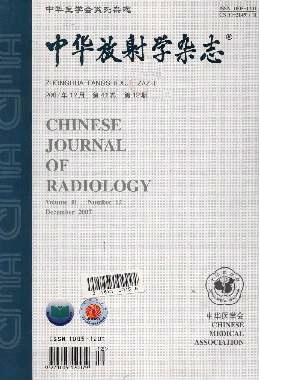Analysis of risk factors related to death in type A aortic intramural hematoma with conservative therapy
Q4 Medicine
Zhonghua fang she xue za zhi Chinese journal of radiology
Pub Date : 2020-03-10
DOI:10.3760/CMA.J.ISSN.1005-1201.2020.03.005
引用次数: 0
Abstract
Objective To explore risk factors of death in type A intramural hematoma (IMH) patients with conservative therapy and provide important information for clinical risks stratification and decisions-making. Methods This retrospectively study enrolled 130 patients diagnosed with type A IMH in the first CT examination at Fuwai Hospital of Chinese Academy of Medical Sciences and only received conservative therapy between September 2009 and June 2018. Baseline clinical and CT characteristics were recorded. All patients enrolled were followed up. The endpoint was aortic disease-related death, patients were divided into endpoint group and non-endpoint group according to whether or not an endpoint event occurs. Difference between two groups of normally distributed continuous variables, non-normally distributed continuous variables and categorical variables were tested by independent sample t test, Mann-Whitney U test and chi-square test or Fisher′s exact test, respectively. Independent risk factors related to outcomes were assessed with Cox regression analysis and survival analysis. Results In baseline CT data, the mean value of the maximum aortic diameter (MAD) was (49.2±6.9) mm, and the median value of the maximum hematoma thickness (MTH) was 11.0 (8.5, 13.2) mm. There were 56 and 30 patients with ulcer-like projection (ULP) and intramural blood pool (IBP), respectively, which including 36 patients with ULP of ascending aorta, 51 patients with pericardial effusion and 50 patients with pleural effusion. During a median follow-up time of 1 050 (242, 1 949) days, 26 patients experienced aortic disease-related death. Compared with non-endpoint group patients, patients who experienced aortic disease-related death showed older age and larger MAD(t=2.363, 3.640, P=0.020,<0.001), higher proportion of aortic atherosclerosis, ULP and pericardial effusion (χ2=5.275, 6.596, 9.325, P=0.022, 0.010, 0.002).In Cox regression multivariate analysis shows that aortic atherosclerosis [hazard ratio (HR)=3.48, P=0.043], ULP (HR=2.66, P=0.019) and pericardial effusion (HR=2.49, P=0.030) were independent risk factors for aortic disease-related death. Conclusions Aortic atherosclerosis, ULP and pericardial effusion are independent predictors of subsequent aortic disease-related death for type A IMH patients with conservative therapy, identifying these risk factors is helpful for further risk stratification and decisions-making. Key words: Aorta; Hematoma; Tomography, X-ray computed; Risk factor保守治疗A型主动脉壁内血肿死亡的危险因素分析
目的探讨A型颅内血肿(IMH)患者保守治疗后死亡的危险因素,为临床风险分层和决策提供重要信息。方法回顾性研究2009年9月至2018年6月中国医学科学院阜外医院首次CT检查诊断为A型IMH的患者130例,仅接受保守治疗。记录基线临床和CT特征。所有入组患者均接受随访。终点为主动脉疾病相关死亡,根据是否发生终点事件分为终点组和非终点组。两组正态分布连续变量、非正态分布连续变量和分类变量之间的差异分别采用独立样本t检验、Mann-Whitney U检验和卡方检验或Fisher精确检验。采用Cox回归分析和生存分析评估与预后相关的独立危险因素。结果基线CT资料显示,最大主动脉直径(MAD)平均值为(49.2±6.9)mm,最大血肿厚度(MTH)中位数为11.0 (8.5,13.2)mm,溃疡样突出(ULP) 56例,壁内血池(IBP) 30例,其中升主动脉ULP 36例,心包积液51例,胸膜积液50例。在中位随访时间1050(242,1949)天期间,26例患者发生主动脉疾病相关死亡。与非终点组相比,主动脉疾病相关死亡患者年龄更大,MAD更大(t=2.363、3.640,P=0.020,<0.001),主动脉粥样硬化、ULP、心包积液比例更高(χ2=5.275、6.596、9.325,P=0.022、0.010、0.002)。Cox回归多因素分析显示,主动脉粥样硬化[危险比(HR)=3.48, P=0.043]、ULP (HR=2.66, P=0.019)和心包积液(HR=2.49, P=0.030)是主动脉疾病相关死亡的独立危险因素。结论主动脉粥样硬化、ULP和心包积液是经保守治疗的A型IMH患者后续主动脉疾病相关死亡的独立预测因素,识别这些危险因素有助于进一步进行风险分层和决策。关键词:主动脉;血肿;断层扫描,x射线计算机;风险因素
本文章由计算机程序翻译,如有差异,请以英文原文为准。
求助全文
约1分钟内获得全文
求助全文
来源期刊

Zhonghua fang she xue za zhi Chinese journal of radiology
Medicine-Radiology, Nuclear Medicine and Imaging
CiteScore
0.30
自引率
0.00%
发文量
10639
 求助内容:
求助内容: 应助结果提醒方式:
应助结果提醒方式:


